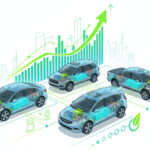Getting more people to switch to electric vehicles hasn’t been easy. High prices, limited driving range, and a lack of convenient charging options have kept many buyers from making the switch. For some, the idea of relying solely on battery power feels risky—especially with long road trips.
Here comes extended-range electric vehicles (EREVs), solving the challenges holding back EV sales. They combine battery-powered driving with the comfort of a backup gasoline generator. This blend makes them a practical choice for people who are unsure about fully committing to electric cars. It’s also a move that could push more drivers toward greener options.
So, are EREVs the key to speeding up the transition to greener driving? Stick around as we break down how these vehicles work and why they might be the growth boost electric cars need.
Why EREVs Are Gaining Popularity
The appeal of the EREV comes down to solving the biggest problems that make buyers hesitate to go fully electric.
- Solving Range Anxiety
Range anxiety is the top reason many consumers prefer traditional gas cars. EREVs are designed to eliminate this fear.
Drivers can handle their daily commute entirely on battery power. The average EREV in China in 2024, for example, had an electric-only range of 170 kilometers (105 miles). Some newer models offer electric ranges of 100 to 200 miles.
When this battery becomes depleted, the gas generator is turned on, offering hundreds of miles more. This provides EREVs with an overall driving range that is similar to internal combustion engine (ICE) vehicles. For instance, the upcoming Ram 1500 Ramcharger pickup reports a total range of 690 miles.
Such capability is particularly useful with trucks and SUVs. Did you know? Towing a heavy trailer can cut a BEV’s range in half. For that reason, drivers are being forced to stop frequently for long charging sessions, which can be complicated if the trailer has to be disconnected. With an EREV, the driver can simply refuel the generator at a gas station in minutes.
- Accessibility in Charging-Scarce Areas
EREVs are a viable choice for individuals who do not have sufficient access to charging. This covers drivers who stay in apartments without charging system at home or those residing in rural locations where charging stations are few.
The vehicle remains perfectly usable, running on its generator until the driver can plug it in again. Such flexibility enables EREVs to become one of the best solutions in areas with limited charging infrastructure.
- Cost Effectiveness vs. BEVs (Battery Electric Vehicles)
To give a BEV a 500-mile range, it needs a massive, heavy, and expensive battery. Well, an EREV doesn’t.
Since the long-range distance is offered by the gas generator, a much smaller and lighter battery pack can be deployed on an EREV. A McKinsey modeled scenario found that an EREV pickup needing a 150-mile electric range could use a 68 kWh battery. A comparable BEV needing a 500-mile range would require a 228 kWh battery pack.
This difference makes the EREV powertrain significantly cheaper to produce. The analysis suggests an EREV powertrain could cost 30% to 40% less than a BEV powertrain, with potential savings as high as $6,000. Some estimates suggest EREVs are about 10% cheaper than their pure-electric counterparts. Assuming that automakers transfer these savings to the consumer, EREVs may turn into a more affordable form of electric driving.
Global Market Trends
The EREV concept is not new, but it is experiencing a powerful resurgence, particularly in one major market.
- Sales Growth in Major Markets
China has embraced EREVs. Fueled by strong consumer demand, EREVs are the fastest-growing drivetrain globally.
In 2024, sales of extended-range EVs in China increased by an estimated 83% to 1.2 million units (other estimates put the figure at 79%). While they are still outsold by PHEVs (3.4 million) and BEVs (6.3 million), their momentum is undeniable. According to a BloombergNEF report, EREV will be more widespread in China than plug-in hybrids by the decade.
In Europe, however, EREVs remain rare. Only two models are currently available: the Mazda MX-30 R-EV and the Leapmotor C10 REEV. Even Volkswagen expressed doubts about its relevance for the European market.
Also Read: How Auto Insights 2025 Improves Business Operations
- OEM (Original Equipment Manufacturer) Investments
The success in China has captured the attention of automakers in the United States. Several manufacturers see EREVs as a vital bridge to full electrification.
➜ Stellantis delayed its all-electric Ram 1500 REV to prioritize the Ram 1500 Ramcharger, an EREV pickup.
➜ Scout Motors, a VW-backed brand, will offer EREV versions (called “Harvester”) of its upcoming trucks and SUVs. The company stated that 25% of its pre-orders are for the EREV configuration.
➜ Ford’s CEO, Jim Farley, has said EREVs are a “necessary bridge,” especially for the popular American truck and SUV segments.
➜ Nissan and Hyundai have also announced plans to develop EREVs.
Challenges and Opportunities for EREVs
Despite the momentum, EREVs face significant hurdles. They are not a silver bullet, and some critics consider them to be a “dead-end technology”.
- Challenges
- The “PHEV Shortfall”: The climate benefit of any plug-in vehicle depends entirely on user behavior. EREVs also have a chance of repeating the failure of plug-in hybrids (PHEVs). Real-world data shows PHEVs emit 3.6 times more CO2 than official tests suggest, largely because many drivers do not charge them regularly. If EREV owners rely on the gas generator for most of their driving, the vehicles become a “climate liability”.
- Inefficiency on Gas: Once the battery is depleted, an EREV is just a heavy car powered by gasoline. A recent T&E analysis of top-selling Chinese EREV models found that after the battery runs out, they consume an average of 6.4 litres per 100 km (about 37 mpg). The report notes this is “no better than a conventional petrol SUV”.
- Misleading Marketing: Critics point out that advertised range figures can be deceptive. While the total range is high, the actual electric range can be quite low. The Mazda MX-30 R-EV, for example, has an electric range of only 85 km (53 miles).
- Consumer Confusion: EREVs face a major marketing challenge. Consumers are already “overwhelmed” by the different types of electrified powertrains. A McKinsey survey found that 48% of US car buyers agreed with the statement, “I’m overwhelmed by the number of powertrains…to choose from”. Automakers must clearly educate buyers on how an EREV is different from a PHEV or a standard hybrid, a battle one analyst says is “already lost” if you have to explain the technology.
- Complexity and Maintenance: Unlike a BEV, an EREV still has a gas engine. This adds weight, cost, and complexity. It also means owners still have to deal with traditional maintenance like oil changes and spark plugs
- Opportunities
- The Perfect “Bridge” for ICE Owners: EREVs may be the key to converting drivers who would otherwise never consider a BEV. The McKinsey survey found that when an EREV option was offered, the intent to purchase a traditional ICE vehicle dropped significantly: 12 percentage points in the US, 10 in Germany, and 7 in the UK. EREVs also appeal to current EV owners who are frustrated with charging and considering switching back to gas.
- True EV Driving Experience: Since the electric motors always turn the wheels, an EREV feels like a BEV. Drivers get the instant torque and quiet, smooth acceleration that make EVs popular.
- Hyper-Efficient Engines: The gas engine on an EREV has one easy task: to produce electricity. It does not have to deal with acceleration and gear shifts. This allows it to be optimized to run within a narrow, constant RPM range—its most efficient speed. Through this optimization, amazing thermodynamic efficiency is achieved. BYD and Geely engines, among others, have a rated efficiency of 46-47%, which is much higher than that of a regular car engine (30-35%).
- Regulatory Sweet Spot: The American regulatory environment may be the most favorable market for EREVs. Federal EPA standards tie compliance bonuses to a vehicle’s electric driving range. An EREV with a 70-mile electric range could receive a 65% bonus, while a typical PHEV with a 25-mile range only gets 30%. California’s rules also provide pathways for EREVs.
Future Outlook
So, are EREVs a game-changer or a costly detour? The answer is likely somewhere in the middle.
Most proponents see EREVs as a “bridge technology”—a “missing link” that can help mainstream buyers get comfortable with electric driving. They could smooth the transition away from gas-only cars while the nation’s charging infrastructure is built out.
Once drivers realize they rarely use the gas generator, their next purchase may be a full BEV. In this sense, EREVs will have done their job.
There is also a strong case that EREVs will remain a long-term solution for specific, heavy-duty needs. For those who frequently tow heavy trailers or live in remote areas, an EREV pickup or SUV may always be more practical than a BEV.
Ultimately, the success of EREVs will depend on two factors: education and price. Automakers must make the technology accessible and clearly distinguish it from other hybrids. If they are priced competitively against ICE vehicles, EREVs have a “real shot of going mainstream”. If they cost too much, they could be dead on arrival.
Also Read: How ADAS is Shaping the Future of Electric Vehicles
Conclusion
Indeed, long-range electric vehicles may be a significant step to electrify more drivers. With the growth in charging networks and technological advancements, these kinds of vehicles are a viable solution in overcoming range anxiety and eliminating the barrier between gas and fully electric vehicles. Whether they’re a short-term fix or the start of something bigger, their potential to drive the growth of extended-range EVs is worth keeping an eye on. If you found this article helpful, share it with a friend or colleague to keep the conversation going. Stay tuned for more!
—
Author: Maverick Steel is a writer and digital marketer who enjoys connecting the dots for strategy and engaging content. He spent 6 years in secondary education as a proud campus journalist, specializing in editorial and column writing. Holding a bachelor’s degree in Marketing Management, Maverick is also a devoted advocate for positive cyber citizenship and a certified pet lover. When he’s not busy writing, you can catch him hitting the gym or enjoying a matcha latte at the nearest aesthetic coffee shop.









